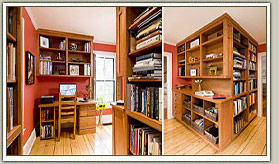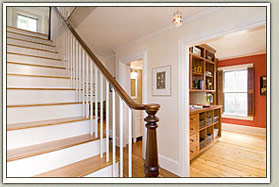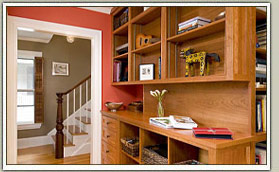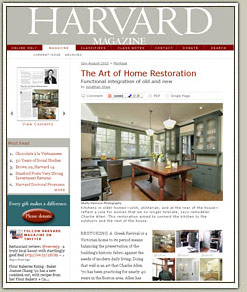| If the content or images below are not being displayed, please click here | ||||||||||||||||||||||||||||||||
 |
||||||||||||||||||||||||||||||||
Charlie Allen Renovations, Inc. |
91 River Street, Cambridge, MA 02139 |
||||||||||||||||||||||||||||||||
|
||||||||||||||||||||||||||||||||
ASK MARK: Lead paint was used in our homes for centuries before health concerns resulted in its being banned more than thirty years ago. Late last year, CAR project development manager Mark Philben and the rest of the CAR team completed training in new federal regulations related to lead paint removal, and are now lead certified remodelers. This quarter, Mark shares what the new regulations mean for you.
At Charlie Allen Renovations, we’ve always taken great care when removing lead paint, ensuring that dust and chips are contained and removed safely from the home. And our entire team was certified in the new regulations late last year, months ahead of the deadline. Here’s what you need to do when hiring a contractor to remove lead paint:
|
||||||||||||||||||||||||||||||||
|
||||||||||||||||||||||||||||||||
WHAT IS A PERIOD HOME?
The first Cape houses were basic structures with appealing clean lines and symmetry. The chimney was always placed at the center of the home, in line with the centrally located front door. A pitched roof with end gables and six-paned windows capped the single-story structure and handsome shutters bracketed the windows. Reverend Timothy Dwight IV (1752-1817) first recognized the Cape as an architectural style. As president of Yale University, he toured Cape Cod in 1800 and later published his impressions of the region in the book Travels in New England and New York (1821-22). Here he describes the simple Cape style: “....The houses in Yarmouth are inferior to those in Barnstable, and much more generally of the class, which may be called with propriety Cape Cod houses. These have one-story, and four rooms on the lower floor; and are covered on the sides, as well as the roofs, with pine shingles, eighteen inches in length. The chimney is in the middle, immediately behind the front door, and on each side of the door are two windows.... This is the general structure and appearance of the great body of houses from Yarmouth to Race Point.... Generally they exhibit a tidy, neat aspect in themselves, and in their appendages, and furnish proofs of comfortable living, by which I was at once disappointed and gratified.” Hard to know why Reverend Dwight was disappointed by the “comfortable living” offered by the Cape style, but clearly, centuries of area homeowners have considered the Cape a particularly cozy and welcoming design, and the style enjoyed a revival, with some changes, between 1930 and 1950. This more modern wave of homes is larger, generally offering two floors of living space and up to 2,000 square feet total. Dormered windows bring light within and architectural character to the exterior. And chimneys, now included for aesthetics rather than necessity, moved from the center of the house to their now standard placement on one side. |
||||||||||||||||||||||||||||||||
EVENTS/CALENDAR
November 5: Renewable Energy Fair: a four day event showcasing new technologies that make efficient and sustainable energy use a reality. At the Museum of Science, Boston. Call 617/723-2500 for more information. November 17 – 19: Build Boston: more than 200 workshops, sessions, symposiums, and tours for members of the building and design trades, at the Seaport World Trade Center. (www.buildboston.com) November 17: The Museum School Art Sale. Now in its 30th year, this annual event offers works from students and alumni at great prices, benefiting the Museum School’s scholarship program. At the School of the Museum of Fine Arts, Boston. 617/267-6100. December 4: The New England Model Train Expo is the region’s largest holiday season train show. At the Best Western Royal Plaza Hotel and Trade Center, Marlborough. 508/460-0700. |
||||||||||||||||||||||||||||||||
|
||||||||||||||||||||||||||||||||
|
||||||||||||||||||||||||||||||||
 Visitors to this 1850s Victorian in Cambridge entered a cramped, dimly lit foyer, their eyes drawn to steep stairs leading up to a dark, second-floor landing. The home’s living area was down a narrow hall while the adjacent front room became a storage area for strollers, coats, books, and other possessions. The homeowners asked us to provide a more welcoming and functional front-of-the-house.
Visitors to this 1850s Victorian in Cambridge entered a cramped, dimly lit foyer, their eyes drawn to steep stairs leading up to a dark, second-floor landing. The home’s living area was down a narrow hall while the adjacent front room became a storage area for strollers, coats, books, and other possessions. The homeowners asked us to provide a more welcoming and functional front-of-the-house. SOLUTIONS: The staircase was rebuilt, creating a more comfortable incline with wider treads. Original period detailing was retained with matching balustrades and handrail, and a larger newel post, an exact design replica of the original. A wall at the second floor landing was removed, creating a larger, bright landing space.
SOLUTIONS: The staircase was rebuilt, creating a more comfortable incline with wider treads. Original period detailing was retained with matching balustrades and handrail, and a larger newel post, an exact design replica of the original. A wall at the second floor landing was removed, creating a larger, bright landing space. The front room, which had become a de facto closet, is now a stylish library/office, with original wide pine flooring and custom-made cherry shelving for books and mementos. With the addition of a coat closet, cold weather gear and strollers are hidden away. The desk is positioned in view of the living room, where the children spend much of their time playing.
The front room, which had become a de facto closet, is now a stylish library/office, with original wide pine flooring and custom-made cherry shelving for books and mementos. With the addition of a coat closet, cold weather gear and strollers are hidden away. The desk is positioned in view of the living room, where the children spend much of their time playing. Q: I’ve heard that there are new federal regulations regarding lead paint that affect every home in the U.S. built before 1978. What do I need to know?
Q: I’ve heard that there are new federal regulations regarding lead paint that affect every home in the U.S. built before 1978. What do I need to know?
 “Cape” style housing is quite popular in Greater Boston, which is not surprising as the Cape was first popularized on Cape Cod in the 17th century, when the dwellings were known as Cape Cod cottages.
“Cape” style housing is quite popular in Greater Boston, which is not surprising as the Cape was first popularized on Cape Cod in the 17th century, when the dwellings were known as Cape Cod cottages.